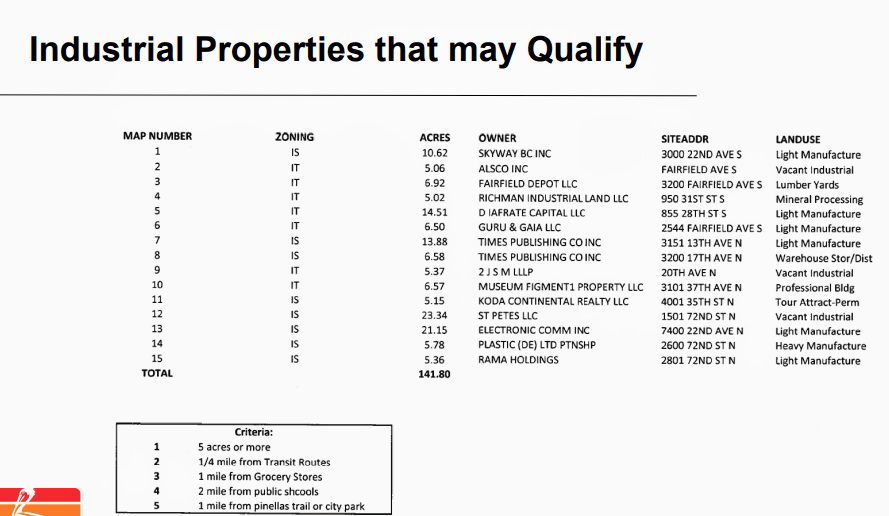Thrive
Mixed-income projects could qualify for housing program

Housing experts praised St. Petersburg officials for approving the transformation of a lumber yard into housing with 100% affordable units; they are now considering adopting a similar process with a requirement of just 30%.
During Thursday’s meeting, city council members discussed amending the City Code to allow mixed-income projects in industrially zoned districts, per Senate Bill 962, which passed earlier this year. City administrators recommend developments offer at least 300 total units and allow up to 10,000 square feet of commercial space.
Earlier in the meeting, Mayor Ken Welch formally recognized St. Petersburg for receiving two awards at a recent Florida Housing Coalition Conference. One was for becoming the first city in the state to capitalize on 2020’s HB1339 when it approved turning the industrially zoned Tibbets Lumber Yard into the Fairfield Avenue Apartments. It will provide 264 affordable units.
“We just approved our first project for the industrial lands with 100% affordability,” said Councilmember Richie Floyd. “And this immediately moves it to 30%?”
Amy Foster, community and neighborhood affairs administrator, explained the different criteria with SB962, which she called “very specific” to each property. She added that only 15 parcels in the city would qualify and said it offers a narrower scope than the previous process.
Lawmakers stipulated in SB962 that developers set aside just 10% of units as affordable. The governor signed the bill into law in June, and the amendment to the City Code would contain most of the strict criteria found in the previous procedure.
That includes requiring those parcels to exist within two miles of a public school, one mile of a grocery store, city park or the Pinellas Trail, and a quarter-mile of a PSTA bus line.

A list of the 15 properties that could qualify under the proposed changes to City Code. Screengrab.
Administrators did propose increasing the affordability requirement to 30%, with 50% of those designated for buyers or renters making at or below 80% of the area median income (AMI). The amendment would also mandate an affordability period of 30 years, and officials hope to make the process more enticing to developers.
“In order to incentivize and assist in the development of additional affordable and workforce housing, there will be no fees for this application process,” read a document signed by City Attorney Michael Dema.
Floyd said he found the 30% affordability requirement too low, just as he did in a March Housing, Land Use and Transportation (HLUT) meeting. The city has moved forward with the proposed amendment since the governor signed the bill into law in June.
“We just managed to work with the developer to do 100% affordable units on industrial lands,” Floyd reiterated. “And I was optimistic that we’d continue deals like that. Especially, like you described, a lot of the properties qualified for the low-income housing tax credits.”
Foster clarified that she was only referring to the criteria and said, “let’s not marry this with other dollars.”
Multiple developers, added Floyd, have already reached out about the program. He assumed his colleagues have had similar conversations, which he said, “could be a good or a bad thing.” He believes the city could receive additional benefits and relayed his unease with the level of negotiations taking place.
Councilmember Brandi Gabbard noted that during initial discussions, she wanted to set the bar much higher than the legislature’s 10% affordability threshold. Luckily, lawmakers allowed municipalities to establish requirements.
Even after the proposed increase to 30%, Gabbard said she remained hesitant due to the success of utilizing HB1339 and was cautious not to “dilute that work.” However, after working closely with the Affordable Housing Advisory Committee (AHAC), she realized that few city parcels would qualify due to stipulations regarding the number of units and commercial space.
“There is actually going to be very few of those 15 parcels that would even be feasible,” said Gabbard. “Probably seven acres or more is what we’re talking about, and those particular parcels – to do a hundred percent affordable housing on those would be next to impossible.”
Gabbard relayed her belief that developers will continue taking advantage of HB1339 on smaller properties. She called the proposed amendment another tool in the city’s toolbox to create some affordable housing on otherwise vacant lots.
Council members voted 6-1 to move forward with the proposed change to City Code, with Floyd dissenting.







